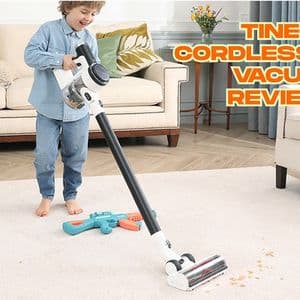Why Handheld Vacuums Are Worth Considering
Let’s face it—dragging out a full-size vacuum for every spill is impractical. That’s where handheld vacuums shine.
Designed for portability and ease of use, handheld vacuums are compact devices that deliver quick cleaning power in tight areas. They’re ideal for stairs, upholstery, car interiors, and spot cleaning in high-traffic areas. Many homeowners now keep one in the kitchen or living room for fast cleanup after kids or pets.
But here’s the catch: Not all handheld vacuums perform the same.
Some prioritize suction power, while others focus on battery life or attachments. Understanding these differences is the first step to choosing a unit that actually fits your lifestyle.
Key Features to Look For in Handheld Vacuums
Before diving into handheld vacuum reviews, it's important to understand what separates a high-performing model from one that falls short. Here’s what to keep an eye on:
1. Suction Power
This is the core of any vacuum's performance. For handheld models, suction strength determines how well it handles pet hair, dirt, or heavier debris like cereal or gravel. Units with high-voltage motors or advanced cyclonic technology generally offer better performance.
Tip: Look for manufacturer specs in air watts or motor voltage as a guide to suction capability.
2. Battery Life and Charging Time
If you're going cordless—and most handheld vacuums are—battery performance is critical. The best models offer at least 15–30 minutes of runtime with reasonable charging times of under 4 hours.
Short battery life may be tolerable for occasional use, but if you plan to use your vacuum regularly or in larger spaces, it’s worth investing in a longer-lasting unit.
3. Weight and Ergonomics
Here’s something people often overlook.
A vacuum might have great suction, but if it’s heavy or awkward to hold, you won’t use it as often. Most handhelds weigh between 2 and 5 pounds. Look for a well-balanced design with an easy-to-hold grip, especially if you have wrist or shoulder issues.
4. Dustbin Capacity
Smaller vacuums have smaller dustbins—but the trade-off is frequency of emptying. For quick jobs, even a 0.3-liter capacity might be enough. But if you’ll use it frequently or for pet hair, opt for models with larger containers or easy-empty mechanisms.
5. Attachments and Tools
Don’t underestimate the power of the right tool.
Crevice tools, brush attachments, pet hair nozzles, and extension hoses can significantly expand the vacuum’s capabilities. If you plan to clean in your car or on upholstery, these extras become essential.
Corded vs. Cordless: What’s Right for You?
Here’s the deal.
Most consumers today lean toward cordless handhelds for the convenience factor. But corded models still have a place—especially if you want unlimited runtime and slightly more power for the price.
Corded handhelds work well for:
-
Long cleaning sessions
-
Areas with nearby power outlets
-
Households that don’t mind managing a cord
Cordless handhelds are better for:
-
Flexibility and portability
-
Quick spot cleaning
-
Keeping in vehicles or outdoor storage
It ultimately comes down to how and where you plan to use the vacuum. If you already own cordless stick vacuums, adding a handheld unit complements your cleaning toolkit nicely.
Common Use Cases for Handheld Vacuums
Let’s break it down further.
Understanding how you’ll use a handheld vacuum can narrow your options quickly. Here are common scenarios:
Pet Owners
Pet hair is a constant battle, especially on furniture or stairs. A strong motor and a motorized brush attachment are essential. Models that specialize in pet cleanup often include high-efficiency filters to trap allergens as well.
Vehicle Interiors
If you clean your car regularly, look for a model with a crevice tool and long nozzle. Cordless designs make it easier to reach under seats or into tight console spaces.
Apartment or Dorm Living
In small spaces, a handheld vacuum can serve as your primary tool. Opt for models with decent battery life and a multipurpose brush head.
Supplement to Full-Size Vacuums
Many households use handheld vacuums to supplement larger machines. This is especially helpful for staircases, upholstery, or sudden messes where hauling out a full unit isn't practical.
How Handheld Models Compare to Other Vacuum Types
So how do handheld vacuums stack up against other types?
While they can’t replace upright or canister vacuums for full-home deep cleaning, they outperform in speed and accessibility. Compared to the best cordless stick vacuums, handhelds are even more portable—although they trade off some power and coverage area.
In essence, handheld units are the most specialized option. They’re designed for specific tasks, not general whole-home cleaning.
If you’re looking for the best vacuum cleaner for everyday use, handheld models work best when paired with a more powerful upright or stick model. Together, they create a complete home-cleaning solution.
Final Thoughts
Here’s the bottom line.
Reading handheld vacuum reviews gives you a head start, but understanding your needs makes all the difference. Whether it’s battery life, suction strength, or ergonomic comfort, your ideal vacuum depends on how and where you’ll use it.
Still unsure where to start? Begin with how often you clean, what surfaces you're dealing with, and whether portability or runtime matters more. Once those priorities are clear, matching them to the right model becomes much easier.
When chosen well, a handheld vacuum can be one of the most useful cleaning tools in your home.






















